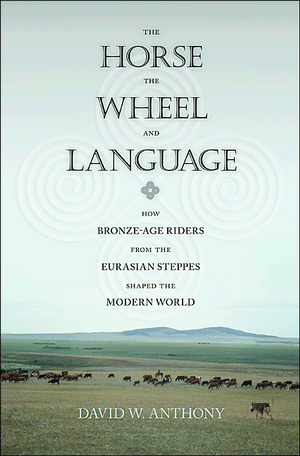1 June 2015
Book review: The Horse, the Wheel, and Language by David W. Anthony
 The Horse, the Wheel, and Language — How Bronze-Age Riders from the Eurasian Steppes Shaped the Modern World
The Horse, the Wheel, and Language — How Bronze-Age Riders from the Eurasian Steppes Shaped the Modern World
David W. Anthony
Princeton University Press, Princeton
November 2007
566 pages
ISBN: 978-0-691-05887-0
Probably the first great achievement of historical linguistics was the discovery of the Indo-European language family. We now know that Germanic, Romance, Slavic, Baltic, Greek, Albanian, Armenian, Iranian and Indic languages all descend from a common source: Proto-Indo-European (PIE). Most Indo-Europeanists today think that the speakers of PIE lived in the steppe north of the Black Sea, that the different sub-branches were formed when the speakers of PIE started to spread out around 4000BC, and that this process was fueled by the domestication of the horse.
However, there are alternative theories, the most prominent of which claims that the speakers of PIE lived in Anatolia (modern-day Turkey), and that the split occurred around 7000BC, propelled by the spread of agriculture. Proponents of both scenarios agree that while many of the sub-families of PIE formed around the same time, one branch split off first: the now extinct Anatolian languages, the best known member of which was Hittite. Either the speakers of Anatolian moved to Anatolia from the steppe, or the remaining speakers of PIE moved out of Anatolia before splitting up into the other branches.
In The Horse, the Wheel, and Language, David W. Anthony explains in detail why most Indo-Europeanists favour the first option, using both linguistic and archaeological facts and showing how they reinforce each other (thus demonstrating the benefit of close cooperation between the two disciplines). The initial argument is linguistic. The reconstructed vocabulary of PIE contains terms that indicate that its speakers lived in a steppe environment. More to the point, it contains terms related to horses and chariots. We know from archaeological excavations that the horse was not domesticated until about 4000 BC, and before that it lived in the wild only in the steppes.
Anthony also provides a direct argument against the Anatolian origin-hypothesis. The speakers of Anatolian (attested around 2000BC) appear to have constituted a relatively small elite living among a mass of peoples that spoke non-Indo-European languages, including Hattic (possibly related to the North-West Caucasian languages). This makes sense if they were relatively recent newcomers, but it does not if they were the 5000 year old remainder of the culture that brought agriculture to the region. Furthermore, we know that agriculture came to Anatolia from the Middle East, but there is no trace of Indo-European there.
In themselves, these arguments may not appear insurmountable. But Anthony buttresses them by tracing the spread of Indo-European in the archaeological record, making use of many new excavations from recent years, published in Russian-language literature. In particular, he shows how Indo-European languages could reasonably have spread into Europe without directly replacing the population, through a series of patron-client relationships, in which successive groups of non-Indo-European speakers adopted Indo-European language alongside Indo-European culture and technology. Another highlight is the correspondence between funerary customs described in the Family Books of the Rig Veda, the oldest extant Indo-Iranian literature, and those practiced in archeaological sites of Sintashta and Arkaim, to the south-east of the Ural Mountains.
Anthony's command of the archaeological literature is impressive, sometimes overwhelmingly so. The middle of the book contains a number of chapters that are filled to the brim with statistics of archaeological finds, alas leaving the reader struggling for guidance as to their significance with respect to his main argument.
The author also gives a good account of Indo-European linguistics, despite not originally being a linguist. There is a quibble to be had with his Indo-European language tree, which is unbalanced: very specific in some branches (Germanic, Slavic, Celtic), very coarse and incomplete in others (Romance, Greek, Armenian, Indo-Iranian). There is one moment of confusion when he suggests that there exists an empirical question (the 'Indo-Anatolian hypothesis') as to whether perhaps Anatolian should be considered a sister-language to PIE, rather than its eldest daughter. But this is purely a matter of definition: do we define PIE as the most recent common ancestor of the Indo-European languages with or without Anatolian? In either case there is a stage of PIE before and a stage after the split of Anatolian, and both stages are relevant. There may well be a real linguistic issue here but Anthony fails to make clear what it is.
Essentially, The Horse, the Wheel and Language is one long argument to substantiate the steppe-origin of Indo-European. What leaves most to be desired is that more time is not spent on competing explanations of the facts as Anthony presents them. It would have been satisfying to be informed at various junctions of the narrative whether alternative accounts exist at all, and if so, why they are to be discarded. That said, Anthony has succeeded in constructing a convincing history of the Indo-European languages and peoples, which is a great accomplishment. In particular, he shows how linguistic knowledge can open up prehistory, allowing us to learn about the history of peoples before it is written down.